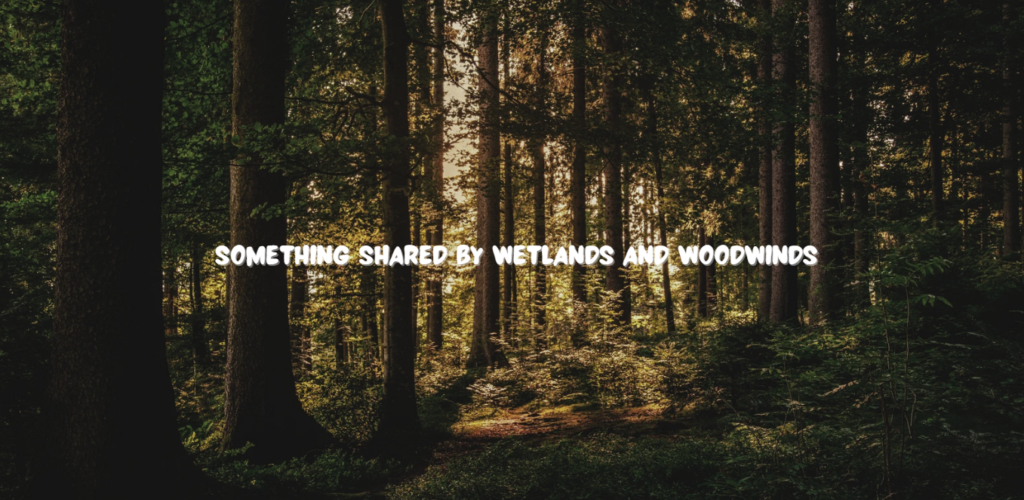Introduction: Exploring the Connection Between Wetlands and Woodwinds
At first glance, wetlands and woodwinds might seem like two completely unrelated concepts—one belongs to the natural world, while the other is firmly rooted in the realm of music. However, there is a fascinating link that binds these two seemingly disparate worlds together: the reed.
Reeds are a crucial element in both the ecosystems of wetlands and the sound production of woodwind instruments. Understanding this shared element offers us a unique perspective on the interconnectedness of nature and human culture.
In this article, we will delve deep into the connection between wetlands and woodwinds, exploring the role of reeds in both environments. We’ll examine the importance of reeds in wetland ecosystems, how they influence the biodiversity of these areas, and their significance in the construction and function of woodwind instruments.
By the end of this comprehensive guide, you’ll have a greater appreciation for the intricate ways in which nature and music intersect, revealing a profound connection that transcends the boundaries of each domain.
Understanding Wetlands: A Vital Ecosystem
What Are Wetlands?
Wetlands are among the most productive and biodiverse ecosystems on Earth. They are areas where water covers the soil or is present near the surface, either seasonally or permanently. Wetlands include marshes, swamps, bogs, and fens, each with its unique characteristics and types of vegetation. These areas are often referred to as the “kidneys” of the planet because of their ability to filter pollutants, regulate water flow, and support a wide variety of plant and animal species.
The Role of Reeds in Wetland Ecosystems
In wetland environments, reeds are more than just plants—they are vital components of the ecosystem. Reeds, particularly those in the genus Phragmites, are tall, perennial grasses that thrive in wet, marshy areas. These plants play several critical roles in wetlands:
- Water Filtration: Reeds help filter and clean water by trapping sediments and absorbing pollutants. Their extensive root systems stabilize the soil and prevent erosion, contributing to the overall health of the wetland.
- Habitat Creation: Reeds provide essential habitat for a variety of wildlife, including birds, amphibians, and insects. They offer shelter, breeding grounds, and feeding areas for many species, making them crucial for maintaining biodiversity.
- Carbon Sequestration: Wetlands are significant carbon sinks, and reeds contribute to this by storing carbon in their biomass and in the soil. This process helps mitigate the effects of climate change by reducing the amount of carbon dioxide in the atmosphere.
Biodiversity in Wetlands: The Impact of Reeds
Reeds are keystone species in many wetland ecosystems, meaning their presence and health have a disproportionately large impact on the environment. They support a wide range of species, including some that are endangered or threatened. The dense reed beds provide nesting sites for birds such as the bittern and the marsh harrier, while also supporting amphibians like frogs and newts that rely on these habitats for survival.
The biodiversity within reed beds is not limited to vertebrates; these areas are also home to countless invertebrates, including dragonflies, water beetles, and snails. The interplay between these species creates a complex web of interactions that contribute to the overall health and stability of the wetland ecosystem.
The World of Woodwinds: The Musical Significance of Reeds
What Are Woodwind Instruments?
Woodwind instruments are a family of musical instruments that produce sound when air is blown into or across a mouthpiece, causing vibrations that generate sound waves. This family includes instruments such as the clarinet, oboe, saxophone, and bassoon. One of the defining characteristics of many woodwind instruments is the use of a reed—a thin strip of material that vibrates to produce sound.
The Role of Reeds in Woodwind Instruments
Reeds are at the heart of many woodwind instruments, determining the quality and character of the sound produced. Reeds are typically made from Arundo donax, a type of cane that grows in wetland areas, although synthetic materials are also used. The reed is attached to the mouthpiece of the instrument, and when air is blown across it, the reed vibrates, creating sound waves that resonate through the instrument’s body.
There are two main types of reeds used in woodwind instruments:
- Single Reeds: Instruments like the clarinet and saxophone use a single reed, which is attached to the mouthpiece and vibrates against it to produce sound.
- Double Reeds: Instruments such as the oboe and bassoon use double reeds, which consist of two reeds bound together. The player blows air between the two reeds, causing them to vibrate against each other and create sound.
Crafting Reeds: A Blend of Art and Science
The process of crafting reeds for woodwind instruments is both an art and a science. The quality of the reed can significantly impact the sound, responsiveness, and playability of the instrument. Reeds must be carefully shaped, trimmed, and adjusted to achieve the desired characteristics. Musicians often spend considerable time selecting and adjusting their reeds to suit their personal playing style and the specific requirements of a piece of music.
Reed-making is a highly specialized skill, and many musicians choose to make their own reeds rather than relying on commercially available options. This allows for greater control over the final product, ensuring that the reed meets the precise needs of the player.
The Shared Element: Reeds as a Bridge Between Wetlands and Woodwinds
The Ecological and Musical Significance of Reeds
The reed serves as a tangible link between wetlands and woodwinds, highlighting the interdependence of nature and human culture. In wetlands, reeds are crucial for maintaining ecosystem health and supporting biodiversity. In music, reeds are essential for the creation of sound in woodwind instruments, enabling musicians to express themselves through their art.
This connection underscores the importance of preserving wetland habitats, not only for the sake of the environment but also for the continuation of musical traditions that rely on natural materials. The degradation of wetlands could have far-reaching consequences, affecting both the ecosystems that depend on reeds and the musicians who rely on them for their craft.
The Role of Conservation in Protecting Reeds
As awareness of the ecological importance of wetlands grows, so too does the understanding of the need to protect these areas. Conservation efforts aimed at preserving wetland habitats are crucial for ensuring the continued availability of natural reeds for both ecological and musical purposes.
Organizations and initiatives dedicated to wetland conservation work to protect these habitats from threats such as pollution, development, and climate change. By safeguarding wetlands, we can ensure that reeds continue to thrive, supporting both the biodiversity of these areas and the cultural heritage of woodwind music.
Innovations in Reed Production: Balancing Tradition and Sustainability
In response to environmental concerns, there has been growing interest in developing sustainable alternatives to natural reeds. Synthetic reeds, made from materials such as plastic or carbon fiber, offer a more durable and consistent option for musicians. These reeds can reduce the demand for natural cane, helping to alleviate some of the pressure on wetland ecosystems.
However, many musicians still prefer the sound and feel of natural reeds, which are often considered superior in terms of tonal quality and responsiveness. As a result, the challenge lies in finding a balance between maintaining traditional reed production and adopting more sustainable practices that protect wetland habitats.
Beyond the Reed: Other Connections Between Nature and Music
The Influence of Nature on Musical Composition
The relationship between nature and music extends beyond the physical materials used to create instruments. Throughout history, composers and musicians have drawn inspiration from the natural world, creating works that reflect the beauty, complexity, and power of the environment.
For example, composers such as Antonio Vivaldi and Ludwig van Beethoven famously incorporated natural themes into their music. Vivaldi’s “The Four Seasons” and Beethoven’s “Pastoral Symphony” are both celebrated examples of how nature can inspire and influence musical composition.
The Soundscapes of Wetlands: A Natural Symphony
Wetlands themselves are rich soundscapes, filled with the calls of birds, the rustling of reeds, and the hum of insects. These natural sounds have been a source of inspiration for musicians and composers, who have sought to capture the essence of these environments in their work.
Field recordings of wetland soundscapes have been used in various musical compositions, adding an element of realism and immersion to the music. These recordings highlight the intricate and dynamic nature of wetland ecosystems, offering listeners a unique auditory experience that connects them to the natural world.
The Future of Reeds: Preserving the Connection Between Wetlands and Woodwinds
The Impact of Climate Change on Wetlands
Climate change poses a significant threat to wetlands, with rising temperatures, changing precipitation patterns, and sea level rise all contributing to the degradation of these ecosystems. As wetlands shrink and disappear, the availability of natural reeds for both ecological and musical purposes may be compromised.
Efforts to combat climate change and protect wetland habitats are essential for preserving the connection between wetlands and woodwinds. By reducing greenhouse gas emissions, restoring degraded wetlands, and implementing sustainable land management practices, we can help safeguard these vital ecosystems for future generations.
Innovations in Reed Cultivation and Harvesting
To address the challenges posed by climate change and habitat loss, researchers and conservationists are exploring new methods for cultivating and harvesting reeds in a sustainable manner. These innovations aim to increase the resilience of reed populations while minimizing the impact on wetland ecosystems.
For example, the development of controlled reed cultivation systems, such as reed beds or artificial wetlands, could provide a stable and sustainable source of reeds for both ecological and musical purposes. These systems could be designed to mimic natural wetland conditions, ensuring that reeds grow in an environment that supports their health and vitality.
The Role of Musicians in Conservation Efforts
Musicians who rely on reeds for their instruments have a unique opportunity to contribute to wetland conservation efforts. By raising awareness of the importance of wetlands and supporting initiatives that protect these habitats, musicians can play a key role in ensuring the continued availability of natural reeds.
In addition, musicians can explore the use of alternative materials, such as synthetic reeds, as part of their commitment to sustainability. While natural reeds remain an important part of woodwind music, the adoption of synthetic options can help reduce the pressure on wetland ecosystems and contribute to the overall health of the environment.
FAQs: Common Questions About Wetlands, Woodwinds, and Reeds
1. What is the primary connection between wetlands and woodwind instruments?
The primary connection between wetlands and woodwind instruments is the reed, a crucial element in both environments. Reeds are essential for maintaining wetland ecosystems and are also used in the production of sound in woodwind instruments.
2. Why are wetlands important for biodiversity?
Wetlands are important for biodiversity because they provide habitat, food, and shelter for a wide variety of species. Reeds, in particular, support a diverse range of wildlife, including birds, amphibians, and invertebrates.
3. How are reeds used in woodwind instruments?
Reeds are used in woodwind instruments to produce sound. When air is blown across or through the reed, it vibrates, creating sound waves that resonate through the instrument. Different types of reeds, such as single or double reeds, are used depending on the instrument.
4. Are synthetic reeds a good alternative to natural reeds?
Synthetic reeds can be a good alternative to natural reeds, offering durability and consistency. However, many musicians still prefer natural reeds for their tonal quality and responsiveness. The choice between synthetic and natural reeds depends on the player’s preferences and the specific requirements of their music.
5. What are some conservation efforts focused on protecting wetlands?
Conservation efforts focused on protecting wetlands include habitat restoration, pollution reduction, and sustainable land management practices. These initiatives aim to preserve wetland ecosystems and the biodiversity they support, including the reeds that are vital for both ecological and musical purposes.
Conclusion: Celebrating the Interconnectedness of Nature and Music
The connection between wetlands and woodwinds, exemplified by the shared element of the reed, offers a powerful reminder of the interconnectedness of nature and human culture. Reeds are not only vital for the health of wetland ecosystems but also play a crucial role in the creation of music, bridging the gap between these two worlds.
As we continue to explore and understand these connections, it is essential to recognize the importance of preserving wetland habitats and supporting sustainable practices in both conservation and reed production. By doing so, we can ensure that the beauty and richness of both nature and music are preserved for future generations to enjoy.

















